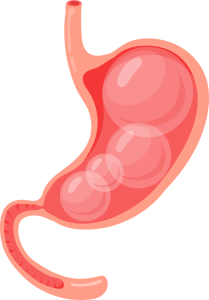Lactose intolerance is a common digestive disorder affecting millions of people worldwide. It occurs when the body has difficulty digesting lactose, a sugar in milk and dairy products. This condition can lead to uncomfortable symptoms after consuming lactose-containing foods.
What is Lactose Intolerance?
Lactose intolerance is a digestive disorder arising from the body’s inability to properly digest lactose, a sugar in milk and dairy products. The condition is characterized by a lactase deficiency, the enzyme responsible for breaking down lactose into its absorbable components, glucose and galactose. Without adequate lactase, undigested lactose passes into the large intestine, which interacts with gut bacteria, leading to uncomfortable symptoms.
Lactase and Lactose Digestion
Lactase is an enzyme produced in the small intestine, specifically in the villi lining, which are tiny finger-like projections that line the intestinal walls. Its primary function is to break down lactose, a complex sugar found in milk and dairy products, into two simpler sugars, glucose and galactose. This process is essential for the body to absorb and utilize these sugars for energy.
When lactase is deficient or not present in sufficient amounts, as in lactose intolerance, lactose remains undigested in the intestine. This undigested lactose then passes into the large intestine, interacting with the gut bacteria. The bacteria ferment the lactose, producing gases (such as hydrogen, carbon dioxide, and methane) and short-chain fatty acids.
The accumulation of gases in the intestines can lead to various symptoms, such as bloating, gas, and abdominal discomfort. Additionally, undigested lactose in the colon can draw water into the colon, leading to diarrhea.
Types of Lactose Intolerance
Lactose intolerance can be classified into several types based on its underlying causes and age of onset. Each type of lactose intolerance is characterized by different factors that lead to the inability to digest lactose properly. The main types of lactose intolerance include:
Primary Lactose Intolerance
This is the most common form of lactose intolerance and occurs when the body starts producing less lactase, the enzyme responsible for breaking down lactose, after childhood. In most cases, primary lactose intolerance is genetic, and its prevalence varies among ethnic groups. For example, people of Asian, African, Native American, and Southern European descent are more likely to develop primary lactose intolerance. The decline in lactase production usually begins around 2 to 5 years and continues into adulthood.
Secondary Lactose Intolerance
Secondary lactose intolerance results from damage to the small intestine’s lining, which can occur due to certain medical conditions or treatments. Celiac disease, inflammatory bowel disease (IBD), gastroenteritis, and chemotherapy can lead to temporary lactase deficiency. Once the underlying condition is treated, the lactase enzyme production may return to normal, and the ability to digest lactose can improve.
Congenital Lactose Intolerance
Congenital lactose intolerance is a rare and genetic form of the condition. It occurs when a baby is born with a complete absence of the lactase enzyme. Symptoms usually appear shortly after birth when the baby is fed lactose-containing breast milk or formula. Infants with this type of lactose intolerance require lactose-free formula or special medical attention to ensure proper nutrition.
Developmental Lactose Intolerance
This type of lactose intolerance occurs in premature infants born with lower lactase levels. As their digestive system matures and lactase production increases, most premature infants gradually overcome this condition and can tolerate lactose without issues.
Primary Lactase Deficiency in Infancy
In some rare cases, babies may be born with normal lactase levels but develop symptoms of lactose intolerance later in infancy. This form is considered a subset of primary lactose intolerance and usually resolves over time as the child’s digestive system develops.
Prevalence of Lactose Intolerance:
The prevalence of lactose intolerance varies widely depending on ethnicity, age, and geographical location. Some populations have a higher prevalence of lactose intolerance, while others have a lower incidence. The prevalence can also change over time due to genetic and environmental factors.
In general, lactose intolerance is more common in populations with a history of dairy farming and animal husbandry. This is because these populations have historically relied less on milk consumption beyond infancy, leading to decreased lactase production over time.
In populations with a high prevalence of lactose intolerance, the ability to digest lactose decreases significantly after weaning. For example, many people of East Asian, African, Native American, and specific Mediterranean backgrounds are more likely lactose intolerant. In contrast, lactose intolerance is less common among people of Northern European descent and some Middle Eastern and South Asian populations.
According to estimates, approximately 65-70% of the global population has some degree of lactose intolerance after infancy. However, lactose intolerance is not a binary condition but exists on a spectrum. Some individuals may experience mild symptoms with small amounts of lactose, while others may have more severe symptoms and must avoid lactose altogether.
Lactase persistence is a genetic trait that allows some individuals to maintain lactase production into adulthood. These individuals can digest lactose without any issues, and lactase persistence is more prevalent in populations that historically practiced dairy farming and consumed milk regularly.
As people from different genetic backgrounds have migrated and intermixed over the centuries, the prevalence of lactose intolerance has been influenced by these historical migrations and dietary practices. For example, lactose intolerance rates have been increasing in some regions due to increased consumption of dairy products and changes in dietary habits.
Distinction from Milk Allergy
Milk allergy is an immune system response to proteins found in milk, primarily casein and whey. It is one of the most common food allergies, especially in infants and young children. When someone with a milk allergy consumes milk or dairy products, their immune system mistakenly identifies these proteins as harmful invaders and launches an allergic reaction. This response triggers the release of immunoglobulin E (IgE) antibodies and histamine, leading to various allergic symptoms.
Symptoms of Milk Allergy
The symptoms of milk allergy can vary widely in severity and may appear shortly after consuming milk or dairy products. Common symptoms include:
- Skin Reactions: Skin rashes, hives (urticaria), itching, and eczema may occur due to the allergic response.
- Respiratory Symptoms: Wheezing, coughing, nasal congestion, runny nose, and shortness of breath can be observed in some cases.
- Gastrointestinal Issues: Nausea, vomiting, abdominal pain, and diarrhea are common digestive symptoms of milk allergy.
- Swelling: Swelling of the lips, face, tongue, throat, or other body parts (angioedema) can occur.
- Anaphylaxis: In severe cases, anaphylaxis may develop, a life-threatening allergic reaction affecting the whole body. Anaphylaxis can lead to a sudden drop in blood pressure, difficulty breathing, and loss of consciousness, and requires immediate medical attention.
Diagnosis of Milk Allergy
A medical professional will typically diagnose milk allergy through medical history, physical examination, and specific allergy tests. These tests may include:
- Skin Prick Test: A small amount of milk extract is placed on the skin, and the area is pricked to allow the allergen to enter the skin. If an allergic reaction occurs (characterized by a raised bump or hive), it indicates a milk allergy.
- Blood Tests: Blood tests, such as the measurement of specific IgE antibodies to milk proteins, can help confirm the presence of a milk allergy.
Treatment and Management of Milk Allergy:
The primary treatment for milk allergy is avoiding milk and all dairy products containing milk proteins. Individuals with milk allergies must carefully read food labels to identify hidden milk sources and avoid cross-contamination.
In cases of accidental milk ingestion or mild allergic reactions, over-the-counter antihistamines may help alleviate symptoms. However, if anaphylaxis occurs, immediate administration of epinephrine (adrenaline) and seeking emergency medical attention is critical.
Causes of Lactose Intolerance
Lactose intolerance occurs when the body cannot produce enough lactase, the enzyme responsible for breaking down lactose, the sugar in milk and dairy products. This deficiency in lactase leads to the incomplete digestion of lactose, resulting in the symptoms associated with lactose intolerance. There are three primary causes of lactose intolerance:
Primary Lactase Deficiency
This is the most common type of lactose intolerance and is usually genetic. As people age, their natural ability to produce lactase tends to decrease. In many cases, lactase production declines after infancy, and some individuals may have a significant lactase deficiency by adulthood. This type of lactose intolerance is more prevalent in certain ethnic groups, including those of Asian, African, Hispanic, and Native American descent.
Secondary Lactase Deficiency
Secondary lactase deficiency can occur due to an injury or illness that affects the small intestine. Celiac disease, inflammatory bowel disease (IBD), bacterial overgrowth, or gastroenteritis can damage the small intestine’s lining, reducing lactase production temporarily. Lactase production may return to normal once the underlying condition is treated or resolved.
Congenital Lactase Deficiency
Congenital lactase deficiency is a rare and severe form of lactose intolerance present from birth. Infants with this condition are born with little to no lactase enzyme, making it impossible to digest lactose. Symptoms usually appear shortly after birth when the infant is fed breast milk or lactose formula. Management of this condition involves using lactose-free infant formulas.
It is essential to differentiate lactose intolerance from a milk allergy. While lactose intolerance involves an issue with lactase enzyme deficiency and is a digestive problem, a milk allergy is an immune response to the proteins in milk and is an allergic reaction. Lactose intolerance is an enzyme deficiency that does not involve the immune system. Therefore, lactose intolerance and milk allergy symptoms and management are distinct.
Symptoms of Lactose Intolerance
Symptoms of lactose intolerance can vary from person to person and may range from mild to severe. The severity of symptoms often depends on the individual’s level of lactase deficiency and the amount of lactose consumed. Some individuals may be able to tolerate small amounts of lactose without experiencing symptoms, while others may have more pronounced reactions. Here are the common symptoms associated with lactose intolerance:
Bloating and Excessive Gas
One of the hallmark symptoms of lactose intolerance is bloating, which refers to a feeling of fullness and tightness in the abdomen. This occurs because undigested lactose in the colon ferments, producing gas. The buildup of gas can lead to abdominal distention and discomfort.
Abdominal Pain and Cramps
Lactose intolerance can cause abdominal pain and cramps, often described as sharp or stabbing. These pains may be intermittent or continuous and usually in the lower abdomen.
Diarrhea
Diarrhea is a common symptom of lactose intolerance. It results from undigested lactose in the colon, drawing water into the intestine and leading to loose and watery stools. The frequency of bowel movements may increase, and diarrhea can be accompanied by urgency.
Nausea and Vomiting
In some cases, lactose intolerance can trigger feelings of nausea, which may be followed by vomiting. However, vomiting is less common than other digestive symptoms and tends to occur in more severe cases.
A feeling of Fullness or Discomfort
People with lactose intolerance often report a general feeling of discomfort or unease after consuming lactose-containing foods. The sensation of fullness may persist for some time after eating, contributing to overall discomfort.
Experiencing Symptoms After Consuming Lactose
Lactose intolerance symptoms typically manifest within 30 minutes to two hours after consuming lactose-containing foods. The timing can vary, with some individuals experiencing symptoms relatively quickly while others may have a delayed response.
Lactose intolerance symptoms are not life-threatening but can significantly impact an individual’s quality of life. If you suspect lactose intolerance, it is essential to consult a healthcare professional for proper diagnosis and guidance. In some cases, other underlying digestive conditions may share similar symptoms with lactose intolerance, so it is crucial to rule out other potential causes. Additionally, managing lactose intolerance involves dietary adjustments and finding suitable lactose-free alternatives to maintain a well-balanced and nutritious diet while minimizing discomfort.
Diagnosing Lactose Intolerance
Diagnosing lactose intolerance involves a combination of clinical evaluation, medical history, and specific diagnostic tests. Here are the main methods used in diagnosing lactose intolerance:
Medical History and Symptom Assessment: The first step in diagnosing lactose intolerance is taking a detailed medical history and evaluating the patient’s symptoms. The healthcare provider will inquire about the type, severity, and duration of digestive symptoms experienced after consuming dairy products. Common symptoms include bloating, gas, abdominal pain, diarrhea, and sometimes nausea.
Elimination Diet: A temporary elimination of lactose-containing foods from the diet is often used as a diagnostic tool. During this period, the patient avoids all dairy products and lactose-rich foods for a few weeks. It suggests lactose intolerance if the symptoms significantly improve or resolve during the elimination phase and reappear when lactose is reintroduced.
Lactose Tolerance Test: This is a commonly used diagnostic test to determine how well the body can digest lactose. The patient is given a lactose-containing beverage, and their blood glucose levels are measured regularly. If the body can digest lactose properly, blood glucose levels will rise because lactose is broken down into glucose and galactose. However, in lactose-intolerant individuals, blood glucose levels may not increase significantly.
Hydrogen Breath Test: This test measures the amount of hydrogen gas in the breath after consuming a lactose solution. Lactose not digested by lactase in the small intestine travels to the colon, where bacteria ferment it, producing hydrogen gas. The exhaled hydrogen is then measured, and elevated levels indicate lactose malabsorption.
Stool Acidity Test: This test is often used for infants and young children. It measures the acidity of the stool after the consumption of lactose. Undigested lactose in the colon can cause an increase in stool acidity.
Genetic Testing: In some cases, genetic testing may identify specific gene variations associated with lactose intolerance, such as the LCT gene that codes for lactase production.
Managing Lactose Intolerance
Managing lactose intolerance involves making dietary adjustments and lifestyle changes to minimize symptoms and ensure adequate nutrition. Here are some strategies for effectively managing lactose intolerance:
Limit Lactose Intake: The primary approach to managing lactose intolerance is to reduce the consumption of foods high in lactose. Dairy products such as milk, cheese, yogurt, and ice cream are familiar sources of lactose. However, many lactose-free or lactose-reduced alternatives are available, including lactose-free milk, yogurt, and lactose-free cheese.
Gradual Introduction: Some individuals with lactose intolerance can tolerate small amounts of lactose without experiencing severe symptoms. Gradually introducing lactose-containing foods and observing tolerance levels can help identify personal thresholds. For example, consuming smaller portions of dairy products or eating lactose-containing foods can be helpful.
Lactase Supplements: Lactase enzyme supplements are available over-the-counter and can be taken before consuming lactose-containing foods. These supplements help break down lactose in the digestive system, making it easier to digest. Lactase drops or tablets are commonly used and can benefit those who want to enjoy occasional dairy products.
Choose Dairy Alternatives: Plant-based milk alternatives, such as almond milk, soy milk, coconut milk, and oat milk, are lactose-free and can be used as substitutes for dairy milk in various recipes. These alternatives are available in both sweetened and unsweetened varieties.
Fermented Dairy Products: Fermented dairy products like yogurt and kefir may be better tolerated than regular milk because the fermentation process reduces lactose content. Probiotic bacteria in yogurt and kefir can also aid in lactose digestion.
Check Food Labels: It is essential to read food labels carefully to identify hidden sources of lactose in processed foods. Lactose can be present in baked goods, cereals, salad dressings, and medications.
Dietary Calcium: Reducing dairy intake can impact calcium intake, so finding alternative sources of calcium is crucial. Calcium-fortified non-dairy beverages, leafy greens, broccoli, almonds, and canned fish with bones are good calcium sources.
Monitor Vitamin D Levels: Vitamin D is essential for calcium absorption. Individuals with lactose intolerance, especially those who limit dairy intake, should monitor their vitamin D levels and consider supplementation if necessary.
Seek Professional Guidance: If individuals are unsure which foods to include or exclude from their diet, consulting a registered dietitian or healthcare provider is beneficial. They can provide personalized dietary recommendations and ensure nutritional needs are met.
Lifestyle Changes: Maintaining a healthy lifestyle, including regular physical activity and staying hydrated, can contribute to overall digestive health and may alleviate some digestive symptoms.
Managing Lactose Intolerance with Goodness Digestive Enzymes
Goodness Digestive Enzymes contains the enzyme Lactase, specifically helpful for individuals with lactose intolerance. Lactase is the enzyme that breaks down lactose, a sugar in milk and dairy products. The concentration of Lactase in the Goodness Digestive Enzymes is measured in ALU (Acid Lactase Units), which is 1000 ALU per capsule. ALU indicates the enzymatic activity of Lactase in the product.
Here’s how this concentration is effective:
1. Enzymatic Activity: The ALU measurement indicates the enzymatic activity of Lactase. In this case, 1000 ALU represents the amount of Lactase in the product. This activity is essential for breaking lactose into simpler glucose and galactose components.
2. Digestive Aid: For individuals with lactose intolerance, the body lacks sufficient amounts of its Lactase enzyme, leading to difficulty digesting lactose. By supplementing with a product like Goodness Digestive Enzymes, which contains 1000 ALU of Lactase per capsule, individuals can better digest and absorb lactose, reducing symptoms like bloating, gas, and stomach discomfort.
3. Improved Tolerance: The enzymatic activity provided by the Lactase in this product helps individuals tolerate and enjoy dairy products without experiencing the usual discomfort associated with lactose intolerance. It supports the digestion of lactose, allowing for better nutrient absorption.
4. Dosage Consideration: The effectiveness of Lactase supplementation can also depend on the individual’s level of lactose intolerance. Some individuals may require higher or lower concentrations based on the severity of their condition. The 1000 ALU concentration is a common and effective dosage for many individuals with mild to moderate lactose intolerance.
In summary, the 1000 ALU concentration of Lactase in Goodness Digestive Enzymes is effective by providing the necessary enzymatic activity to assist in the breakdown of lactose, improving digestive comfort for individuals with lactose intolerance.





